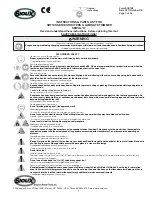
Operating Instructions
Page 6-12
27C
C
LEARING
A
F
ILM
J
AM
(W
RAP
-
UP
)
Film jams (wrap-ups) may occur if the film is loaded
backwards or if the area at which film exits the
equipment is blocked. The film, when jammed, wraps
around the rollers. Jams also occur if something is
too large to pass through the rollers.
Determine the best course of action to clear the
jam. It may be necessary to rotate the rollers in the
reverse direction. Set the speed to
min.
Press and
hold the
REVERSE
button on the control panel.
CAUTION:
Be careful to not cut the pressure rollers
when cutting the film. Failure to observe this notice
can result in damage to the rollers.
To clear a jam:
Immediately press the
STOP
button to stop the
machine.
Remove the safety shield and feed tray.
Do one of the following.
Pull one of the webs while running the
laminator in reverse.
Cut the film near the rollers, set the
pressure adjustment to
Release,
and pull
the film out the back of the machine.
Cut the film near the rollers, set the
pressure adjustment to
Release,
grasp
the loose ends of the web, and pull
straight out the front of the machine.
Replace the safety shield and feed tray.
Re-load the film if necessary. See the
Loading
Film section in this chapter.
1.
2.
3.
a.
b.
c.
4.
5.
L
AMINATION
G
UIDE
Do not attempt to laminate abrasive or metal objects
such as staples, paper clips and glitter, as they may
damage the rollers.
Do not force items into the nip area of the rollers. An
item that is not easily drawn into the laminator by the
rollers is probably too thick to laminate.
Wrinkles may result if an attempt is made to
reposition an item once it has been grasped by the
rollers.
Do not stop the laminator before an item has
completely exited the pull rollers. Even a momentary
stop may cause a mark on the laminated item.
Good, consistent lamination is a result of combining
proper tension and dwell time. Dwell time is
controlled by the speed of the motor and is defined
as the amount of time the material to be laminated is
compressed between the rollers.
As a general rule, thicker items and film need to run
at slower speeds. Setting the speed control at slower
settings gives the laminator longer dwell time thus
allowing proper lamination of thick items. Thinner
items, such as standard copier paper (20 Ib. bond)
and tissue paper can be run at faster speeds.
Do not combine thick and thin items at the same
time, as this will result in a poor edge seal around
the thinner material. If you are unsure that the
laminator is set at the proper speed for the item to
be laminated, run a test piece (scrap) of the same or
similar material through the laminator. Make speed
adjustments if necessary.
This manual provides general guidelines and is only
a general reference guide. Different settings may be
suitable as the lamination time and materials change.
Test materials before running good materials through
the machine.
Summary of Contents for 27C
Page 3: ...Operating Instructions Page 2 27C...
Page 5: ...Operating Instructions Page ii 27C...
Page 8: ......
Page 9: ...Operating Instructions Page 2 2 27C...
Page 13: ...Operating Instructions Page 4 2 27C...
Page 32: ...Page 7 3 Operating Instructions 27C...
Page 33: ......
























